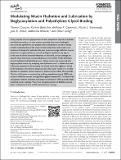| dc.contributor.author | Boettcher, Kathrin | |
| dc.contributor.author | Geonnotti, Anthony R. | |
| dc.contributor.author | Hirsch, Julie B. | |
| dc.contributor.author | Lieleg, Oliver | |
| dc.contributor.author | Crouzier, Thomas | |
| dc.contributor.author | Kavanaugh, Nicole Lynn | |
| dc.contributor.author | Ribbeck, Katharina | |
| dc.date.accessioned | 2017-02-03T21:18:33Z | |
| dc.date.available | 2017-02-03T21:18:33Z | |
| dc.date.issued | 2015-09 | |
| dc.date.submitted | 2015-08 | |
| dc.identifier.issn | 2196-7350 | |
| dc.identifier.uri | http://hdl.handle.net/1721.1/106858 | |
| dc.description.abstract | A key property of mucin glycoproteins is their exceptional capacity to hydrate and lubricate surfaces. In vivo, mucins assemble into mucus hydrogels that cover the epithelium and protect it from dehydration and shear stress. A better understanding of the origin of these properties could lead to new treatment strategies for patients with poor mucus coverage, defective mucus production, or glycosylation as caused by Sjögren syndrome, dry eye, or in the case of certain bacterial infections. In this work, mucin coatings are used to show that mucin-associated glycans are essential for the formation of such hydrated and lubricating layers. Native mucins are compared with deglycosylated mucins by analyzing their hydration and it is shown that their lubricative potential in the boundary and mixed lubrication regime is linked to the hydration. The removal of glycans from the mucin results in a 3.5-fold decrease in hydration and an increase in friction by two orders of magnitude. This loss of function is countered by grafting polyethylene glycol (PEG) molecules to defective mucins through lectin–glycan interactions. This lectin-PEG conjugation restores hydration and improves lubrication of the partially deglycosylated mucin coatings. Thus, local complementation of defective mucus layers could prove to be a useful new treatment strategy. | en_US |
| dc.description.sponsorship | Johnson & Johnson Corporate Office of Science and Technology | en_US |
| dc.description.sponsorship | Marie Curie International Outgoing Fellowship | en_US |
| dc.language.iso | en_US | |
| dc.publisher | Wiley Blackwell | en_US |
| dc.relation.isversionof | http://dx.doi.org/10.1002/admi.201500308 | en_US |
| dc.rights | Creative Commons Attribution-NonCommercial 4.0 International | en_US |
| dc.rights.uri | http://creativecommons.org/licenses/by-nc/4.0/ | en_US |
| dc.source | Wiley | en_US |
| dc.title | Modulating Mucin Hydration and Lubrication by Deglycosylation and Polyethylene Glycol Binding | en_US |
| dc.type | Article | en_US |
| dc.identifier.citation | Crouzier, Thomas et al. “Modulating Mucin Hydration and Lubrication by Deglycosylation and Polyethylene Glycol Binding.” Advanced Materials Interfaces 2.18 (2015): 1500308. | en_US |
| dc.contributor.department | Massachusetts Institute of Technology. Department of Biological Engineering | en_US |
| dc.contributor.mitauthor | Crouzier, Thomas | |
| dc.contributor.mitauthor | Kavanaugh, Nicole Lynn | |
| dc.contributor.mitauthor | Ribbeck, Katharina | |
| dc.relation.journal | Advanced Materials Interfaces | en_US |
| dc.eprint.version | Final published version | en_US |
| dc.type.uri | http://purl.org/eprint/type/JournalArticle | en_US |
| eprint.status | http://purl.org/eprint/status/PeerReviewed | en_US |
| dspace.orderedauthors | Crouzier, Thomas; Boettcher, Kathrin; Geonnotti, Anthony R.; Kavanaugh, Nicole L.; Hirsch, Julie B.; Ribbeck, Katharina; Lieleg, Oliver | en_US |
| dspace.embargo.terms | N | en_US |
| dc.identifier.orcid | https://orcid.org/0000-0001-8260-338X | |
| mit.license | PUBLISHER_CC | en_US |
